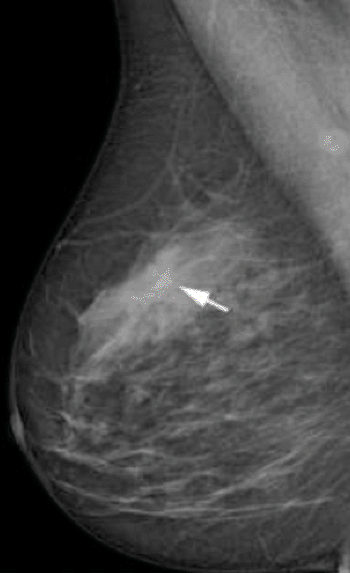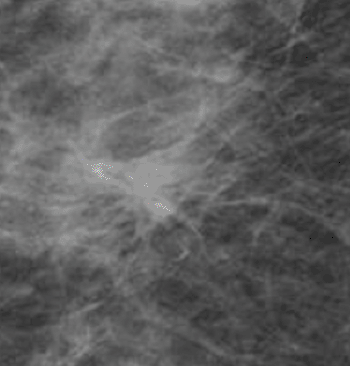Innovative Mammography Technology Increases Detection Rate
|
By MedImaging International staff writers Posted on 18 Feb 2014 |

Image: Two-view screening mammograms obtained with the DR photon-counting system show a spiculated mass in the right upper quadrants (arrow). The diagnosis was invasive ductal carcinoma, 8 mm in diameter, as seen on the right craniocaudal image (Photo courtesy of Radiological Society of North America).

Image: Two-view screening mammograms obtained with the DR photon-counting system show a spiculated mass in the right upper quadrants (arrow). The diagnosis was invasive ductal carcinoma, 8 mm in diameter, as seen on the right mediolateral oblique image (Photo courtesy of Radiological Society of North America).

Image: Two-view screening mammograms obtained with the DR photon-counting system show a spiculated mass in the right upper quadrants. The diagnosis was invasive ductal carcinoma, 8 mm in diameter, as seen on the zoomed in craniocaudal image of the lesion (Photo courtesy of Radiological Society of North America).
A new photon-counting technique used with digital mammography screening has been shown to provide high diagnostic accuracy.
The study’s findings were published online February 2014 in the journal Radiology. While mammography screening has shifted to digital technology, a range of computed radiography (CR) and direct radiography (DR) systems have emerged. The photon-counting technique shows promise as a DR application that employs a unique detector to decrease scattered radiation and noise, enabling dose reduction and making it a promising tool for screening. “In population-based mammography screening, dose reducing techniques that don’t compromise outcome parameters are desirable,” said Walter Heindel, MD, from the department of clinical radiology at the University Hospital Muenster (Muenster, Germany).
For the study, Dr. Heindel and colleagues examined data for the study from the mammography-screening program in North Rhine-Westphalia, the most populated state in Germany. They compared the screening effectiveness of a DR photon-counting scan system with those of statewide operating screening units using different digital technologies. During the study period (2009–2010), 13,312 women were examined using the photon-counting system, and 993,822 women were screened with either CR or DR systems alone.
The DR photon-counting scan system had a cancer detection rate of 0.76% for subsequent screening, compared with 0.59% for the other screening units. The recall rate was 5.4% for the photon-counting technology and 3.4% for the other techniques. “The higher cancer detection resulting from the use of the DR photon-counting scan system is due to high detection of both small, invasive cancers and ductal carcinoma in situ,” Dr. Heindel said.
The photon-counting technique had nearly twice the detection rate of other techniques for ductal carcinoma in situ (DCIS), an early, noninvasive form of the disease. It had a higher DCIS detection rate than the statewide units and the conventional DR subgroup. Moreover, the mean average glandular radiation dose of the DR photon-counting scan system was substantially lower than the traditional DR systems with the individually used parameters of the automatic exposure control. The study’s large size distinguishes it from earlier studies that compared the DR photon-counting scan system’s performance with other approaches. “To our knowledge, the study is different from previous ones as we examined the performance of the DR photon-counting scan mammography on a larger database with consideration of multiple parameters of screening,” said study coauthor Stefanie Weigel, MD, from the University Hospital Muenster.
The photon-counting technique also offers lateral dose modulation during the image acquisition, which can help account for differences in breast density. Cancer frequently is more difficult to identify in women with dense breasts. “The innovative photon-counting technique offers further research potential,” Dr. Heindel said. “One future research direction is the application of spectral imaging for quantification of breast glandular tissue, addressing the problem of breast density.”
Related Links:
University Hospital Muenster
The study’s findings were published online February 2014 in the journal Radiology. While mammography screening has shifted to digital technology, a range of computed radiography (CR) and direct radiography (DR) systems have emerged. The photon-counting technique shows promise as a DR application that employs a unique detector to decrease scattered radiation and noise, enabling dose reduction and making it a promising tool for screening. “In population-based mammography screening, dose reducing techniques that don’t compromise outcome parameters are desirable,” said Walter Heindel, MD, from the department of clinical radiology at the University Hospital Muenster (Muenster, Germany).
For the study, Dr. Heindel and colleagues examined data for the study from the mammography-screening program in North Rhine-Westphalia, the most populated state in Germany. They compared the screening effectiveness of a DR photon-counting scan system with those of statewide operating screening units using different digital technologies. During the study period (2009–2010), 13,312 women were examined using the photon-counting system, and 993,822 women were screened with either CR or DR systems alone.
The DR photon-counting scan system had a cancer detection rate of 0.76% for subsequent screening, compared with 0.59% for the other screening units. The recall rate was 5.4% for the photon-counting technology and 3.4% for the other techniques. “The higher cancer detection resulting from the use of the DR photon-counting scan system is due to high detection of both small, invasive cancers and ductal carcinoma in situ,” Dr. Heindel said.
The photon-counting technique had nearly twice the detection rate of other techniques for ductal carcinoma in situ (DCIS), an early, noninvasive form of the disease. It had a higher DCIS detection rate than the statewide units and the conventional DR subgroup. Moreover, the mean average glandular radiation dose of the DR photon-counting scan system was substantially lower than the traditional DR systems with the individually used parameters of the automatic exposure control. The study’s large size distinguishes it from earlier studies that compared the DR photon-counting scan system’s performance with other approaches. “To our knowledge, the study is different from previous ones as we examined the performance of the DR photon-counting scan mammography on a larger database with consideration of multiple parameters of screening,” said study coauthor Stefanie Weigel, MD, from the University Hospital Muenster.
The photon-counting technique also offers lateral dose modulation during the image acquisition, which can help account for differences in breast density. Cancer frequently is more difficult to identify in women with dense breasts. “The innovative photon-counting technique offers further research potential,” Dr. Heindel said. “One future research direction is the application of spectral imaging for quantification of breast glandular tissue, addressing the problem of breast density.”
Related Links:
University Hospital Muenster
Latest Radiography News
- Novel Breast Imaging System Proves As Effective As Mammography
- AI Assistance Improves Breast-Cancer Screening by Reducing False Positives
- AI Could Boost Clinical Adoption of Chest DDR
- 3D Mammography Almost Halves Breast Cancer Incidence between Two Screening Tests
- AI Model Predicts 5-Year Breast Cancer Risk from Mammograms
- Deep Learning Framework Detects Fractures in X-Ray Images With 99% Accuracy
- Direct AI-Based Medical X-Ray Imaging System a Paradigm-Shift from Conventional DR and CT
- Chest X-Ray AI Solution Automatically Identifies, Categorizes and Highlights Suspicious Areas
- AI Diagnoses Wrist Fractures As Well As Radiologists
- Annual Mammography Beginning At 40 Cuts Breast Cancer Mortality By 42%
- 3D Human GPS Powered By Light Paves Way for Radiation-Free Minimally-Invasive Surgery
- Novel AI Technology to Revolutionize Cancer Detection in Dense Breasts
- AI Solution Provides Radiologists with 'Second Pair' Of Eyes to Detect Breast Cancers
- AI Helps General Radiologists Achieve Specialist-Level Performance in Interpreting Mammograms
- Novel Imaging Technique Could Transform Breast Cancer Detection
- Computer Program Combines AI and Heat-Imaging Technology for Early Breast Cancer Detection
Channels
MRI
view channel
World's First Whole-Body Ultra-High Field MRI Officially Comes To Market
The world's first whole-body ultra-high field (UHF) MRI has officially come to market, marking a remarkable advancement in diagnostic radiology. United Imaging (Shanghai, China) has secured clearance from the U.... Read more
World's First Sensor Detects Errors in MRI Scans Using Laser Light and Gas
MRI scanners are daily tools for doctors and healthcare professionals, providing unparalleled 3D imaging of the brain, vital organs, and soft tissues, far surpassing other imaging technologies in quality.... Read more
Diamond Dust Could Offer New Contrast Agent Option for Future MRI Scans
Gadolinium, a heavy metal used for over three decades as a contrast agent in medical imaging, enhances the clarity of MRI scans by highlighting affected areas. Despite its utility, gadolinium not only... Read more.jpg)
Combining MRI with PSA Testing Improves Clinical Outcomes for Prostate Cancer Patients
Prostate cancer is a leading health concern globally, consistently being one of the most common types of cancer among men and a major cause of cancer-related deaths. In the United States, it is the most... Read moreUltrasound
view channel
First AI-Powered POC Ultrasound Diagnostic Solution Helps Prioritize Cases Based On Severity
Ultrasound scans are essential for identifying and diagnosing various medical conditions, but often, patients must wait weeks or months for results due to a shortage of qualified medical professionals... Read more
Largest Model Trained On Echocardiography Images Assesses Heart Structure and Function
Foundation models represent an exciting frontier in generative artificial intelligence (AI), yet many lack the specialized medical data needed to make them applicable in healthcare settings.... Read more.jpg)
Groundbreaking Technology Enables Precise, Automatic Measurement of Peripheral Blood Vessels
The current standard of care of using angiographic information is often inadequate for accurately assessing vessel size in the estimated 20 million people in the U.S. who suffer from peripheral vascular disease.... Read moreNuclear Medicine
view channel
New Imaging Technique Monitors Inflammation Disorders without Radiation Exposure
Imaging inflammation using traditional radiological techniques presents significant challenges, including radiation exposure, poor image quality, high costs, and invasive procedures. Now, new contrast... Read more
New SPECT/CT Technique Could Change Imaging Practices and Increase Patient Access
The development of lead-212 (212Pb)-PSMA–based targeted alpha therapy (TAT) is garnering significant interest in treating patients with metastatic castration-resistant prostate cancer. The imaging of 212Pb,... Read moreNew Radiotheranostic System Detects and Treats Ovarian Cancer Noninvasively
Ovarian cancer is the most lethal gynecological cancer, with less than a 30% five-year survival rate for those diagnosed in late stages. Despite surgery and platinum-based chemotherapy being the standard... Read more
AI System Automatically and Reliably Detects Cardiac Amyloidosis Using Scintigraphy Imaging
Cardiac amyloidosis, a condition characterized by the buildup of abnormal protein deposits (amyloids) in the heart muscle, severely affects heart function and can lead to heart failure or death without... Read moreGeneral/Advanced Imaging
view channel
Radiation Therapy Computed Tomography Solution Boosts Imaging Accuracy
One of the most significant challenges in oncology care is disease complexity in terms of the variety of cancer types and the individualized presentation of each patient. This complexity necessitates a... Read more
PET Scans Reveal Hidden Inflammation in Multiple Sclerosis Patients
A key challenge for clinicians treating patients with multiple sclerosis (MS) is that after a certain amount of time, they continue to worsen even though their MRIs show no change. A new study has now... Read moreImaging IT
view channel
New Google Cloud Medical Imaging Suite Makes Imaging Healthcare Data More Accessible
Medical imaging is a critical tool used to diagnose patients, and there are billions of medical images scanned globally each year. Imaging data accounts for about 90% of all healthcare data1 and, until... Read more
Global AI in Medical Diagnostics Market to Be Driven by Demand for Image Recognition in Radiology
The global artificial intelligence (AI) in medical diagnostics market is expanding with early disease detection being one of its key applications and image recognition becoming a compelling consumer proposition... Read moreIndustry News
view channel
Hologic Acquires UK-Based Breast Surgical Guidance Company Endomagnetics Ltd.
Hologic, Inc. (Marlborough, MA, USA) has entered into a definitive agreement to acquire Endomagnetics Ltd. (Cambridge, UK), a privately held developer of breast cancer surgery technologies, for approximately... Read more
Bayer and Google Partner on New AI Product for Radiologists
Medical imaging data comprises around 90% of all healthcare data, and it is a highly complex and rich clinical data modality and serves as a vital tool for diagnosing patients. Each year, billions of medical... Read more

















